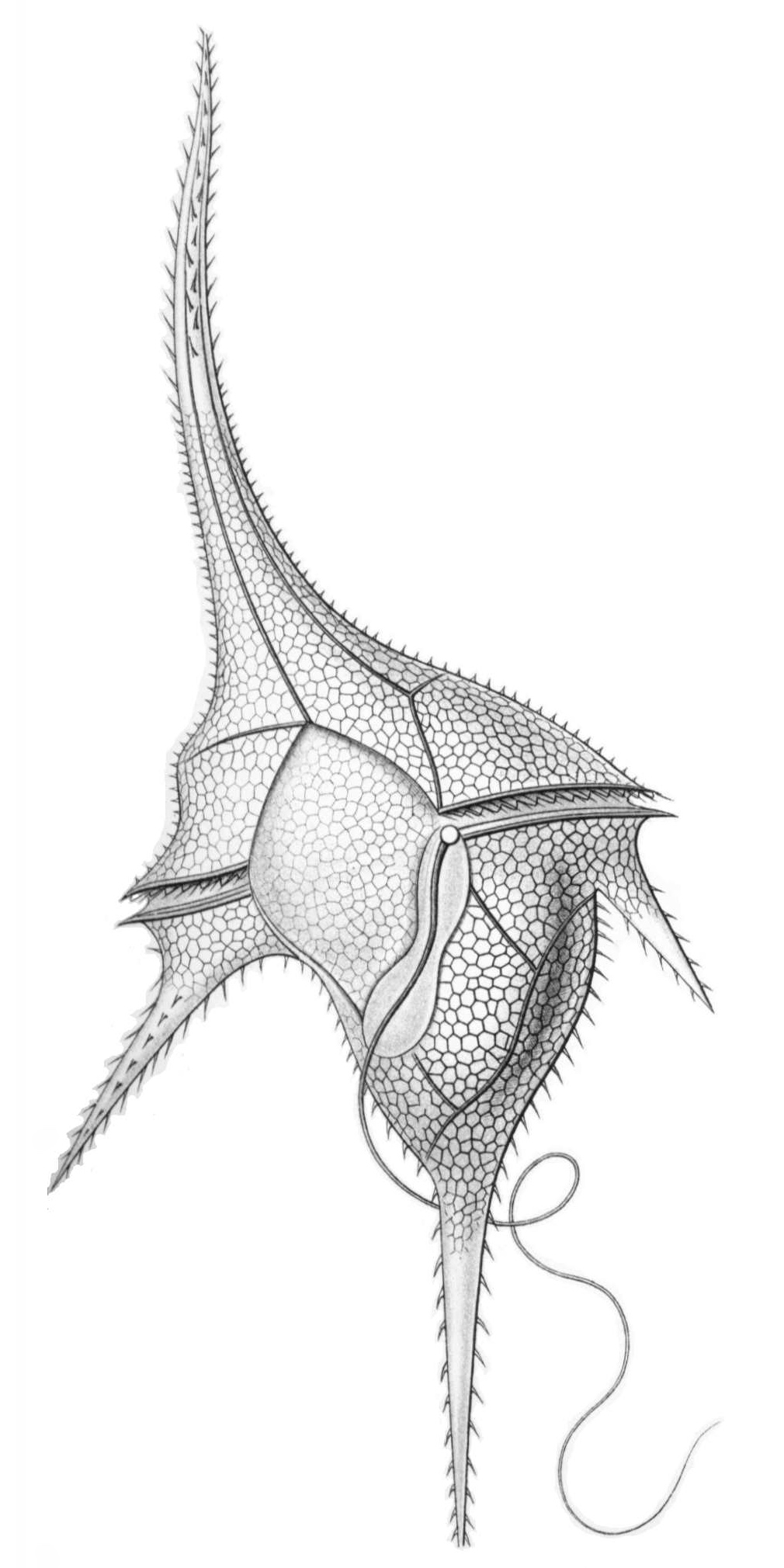|
Ceratium
The genus ''Ceratium'' is restricted to a small number (about 7) of freshwater dinoflagellate species. Previously the genus contained also a large number of marine dinoflagellate species. However, these marine species have now been assigned to a new genus called ''Tripos''. ''Ceratium'' dinoflagellates are characterized by their armored plates, two flagella, and horns. They are found worldwide and are of concern due to their blooms. Taxonomy The genus was originally published in 1793 by Shrank, F. von Paula. The taxonomy of C''eratium'' varies among several sources. One source states the taxonomy as: Kingdom Chromista, Phylum Miozoa, Class Dinophyceae, Order Gonyaulacales, and Family Ceratiaceae. Another source lists the taxonomy as Kingdom Protozoa, Phylum Dinoflagellata, Class Dinophyceae, Order Gonyaulacales, and Family Ceratiaceae. The taxonomic information listed on the right includes Kingdom Chromalveolate. Thus, sources disagree on the higher levels of classification, ... [...More Info...] [...Related Items...] OR: [Wikipedia] [Google] [Baidu] |
Tripos (dinoflagellate)
''Tripos'' is a genus of marine dinoflagellates in the family Ceratiaceae. It was formerly part of ''Ceratium'', then separated out as ''Neoceratium'', a name subsequently determined to be invalid. Species * '' Tripos aequatorialis'' (Schröder) F.Gómez * '' Tripos aestuarius'' (Schröder) F.Gómez * '' Tripos allieri'' (Gourret) F.Gómez * '' Tripos angustocornis'' (N.Peters) F.Gómez * '' Tripos angustus'' (A.S.Campbell) F.Gómez * '' Tripos arcticus'' (Vanhöffen) F.Gómez * '' Tripos arietinus'' (Cleve) F.Gómez * ''Tripos aultii'' (H.W.Graham & Bronikovsky) F. Gómez * '' Tripos axialis'' (Kofoid) F.Gómez * '' Tripos azoricus'' (Cleve) F.Gómez * '' Tripos balechii'' (Meave del Castillo, Okolodkov & M.E.Zamudio) F.Gómez * ''Tripos balticus'' (F.Schütt) F.Gómez * ''Tripos batavus'' (Paulsen) F.Gómez * ''Tripos belone'' (Cleve) F.Gómez * ''Tripos berghii'' (Gourret) F.Gómez * ''Tripos biceps'' (Claparède & Lachmann) F.Gómez * ''Tripos bicornis'' (Gourret) F.Gómez ... [...More Info...] [...Related Items...] OR: [Wikipedia] [Google] [Baidu] |
Ceratium Furca
''Ceratium furca'' is a species of marine dinoflagellates. Description This species has a straight body which is 70-200 µm long and 30-50 µm wide, with the epitheca gradually tapering into an anterior horn. ''C. furca'' has long spines, and is an "armoured" species with a theca of thick cellulose Cellulose is an organic compound with the formula , a polysaccharide consisting of a linear chain of several hundred to many thousands of β(1→4) linked D-glucose units. Cellulose is an important structural component of the primary cell w ... plates. The cells are nearly flat, with the ventral side concave and the dorsal side being convex. Distribution ''Ceratium furca'' is found worldwide. Subspecies *''Ceratium furca eugrammum'' *''Ceratium furca furca'' References Further reading Dodge, J. D. 1982. Marine Dinoflagellates of the British Isles. Her Majesty's Stationery Office, London. 303 pp. Hansen, G. & Larsen, J. 1992. Dinoflagellater i danske farvande. ... [...More Info...] [...Related Items...] OR: [Wikipedia] [Google] [Baidu] |
Charles Atwood Kofoid
Charles Atwood Kofoid (11 October 1865 – 30 May 1947) was an American zoologist known for his collection and classification of many new species of marine protozoans which established marine biology on a systematic basis. Kofoid also wrote a volume on the biological stations of Europe. In 1920, Kofoid and US zoologist Olive Swezy (1873-1968), published ''Pavillardia'' (a genus of dinoflagellates) in Univ. Calif. Publ. Zool. pages 323-324. It was named in honour of Jules Pavillard. In 1921, Kofoid and Olive Swezy, wrote a book about unarmored dinoflagellates in La Jolla, California, in which they described a new genus called ''Torodinium'' (with ''Torodinium robustum'' and the type species ''Torodinium teredo''). They also published ''Gyrodinium'', which is a genus of dinoflagellates belonging to the order Gymnodiniales in 'Memoirs of the University of California'. vol.5. In 1929, botanist Pavillard first described '' Kofoidinium'', which is a genus of dinoflagellates ... [...More Info...] [...Related Items...] OR: [Wikipedia] [Google] [Baidu] |
Dinoflagellate
The dinoflagellates (Greek δῖνος ''dinos'' "whirling" and Latin ''flagellum'' "whip, scourge") are a monophyletic group of single-celled eukaryotes constituting the phylum Dinoflagellata and are usually considered algae. Dinoflagellates are mostly marine plankton, but they also are common in freshwater habitats. Their populations vary with sea surface temperature, salinity, and depth. Many dinoflagellates are photosynthetic, but a large fraction of these are in fact mixotrophic, combining photosynthesis with ingestion of prey (phagotrophy and myzocytosis). In terms of number of species, dinoflagellates are one of the largest groups of marine eukaryotes, although substantially smaller than diatoms. Some species are endosymbionts of marine animals and play an important part in the biology of coral reefs. Other dinoflagellates are unpigmented predators on other protozoa, and a few forms are parasitic (for example, ''Oodinium'' and ''Pfiesteria''). Some dinoflagellates pro ... [...More Info...] [...Related Items...] OR: [Wikipedia] [Google] [Baidu] |
Algae Families
Algae ( , ; : alga ) are any of a large and diverse group of photosynthetic, eukaryotic organisms. The name is an informal term for a polyphyletic grouping that includes species from multiple distinct clades. Included organisms range from unicellular microalgae, such as ''Chlorella'', ''Prototheca'' and the diatoms, to multicellular forms, such as the giant kelp, a large brown alga which may grow up to in length. Most are aquatic and lack many of the distinct cell and tissue types, such as stomata, xylem and phloem that are found in land plants. The largest and most complex marine algae are called seaweeds, while the most complex freshwater forms are the ''Charophyta'', a division of green algae which includes, for example, ''Spirogyra'' and stoneworts. Algae that are carried by water are plankton, specifically phytoplankton. Algae constitute a polyphyletic group since they do not include a common ancestor, and although their plastids seem to have a single origin, from cyanob ... [...More Info...] [...Related Items...] OR: [Wikipedia] [Google] [Baidu] |


